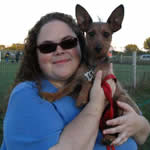FOREVER HOME: NOW WHAT?
By Nomi Berger
Be an informed adopter and make your new dog’s entry into your world as pleasurable as possible.
If this is your first dog, establish yourself with a vet or register your new dog with your established vet. Then apply for the appropriate licenses, etc., required in your area.
Remember that a dog’s true personality may not reveal itself for several weeks. Therefore, these first few weeks require an atmosphere of calm and patience, not anger or punishment.
Knowing your new dog’s established schedules for meals, pottying, walking and exercise beforehand are essential to maintaining his/her sense of continuity.
Once you arrive home, bring your new dog to his/her designated pottying place.
Spend time letting your new dog get accustomed to the place, and if he/she potties, reward him/her with praise and a treat.
Repeat this (whether your dog potties or not) to reinforce it, but be prepared for accidents. Even a housebroken dog will be nervous in, and curious about, new surroundings.
Your new dog may also pant or pace excessively, suffer from stomach upsets or have no appetite at all due to the sudden changes in his/her life.
Give your new dog the same food that he/she ate before.
After 30 minutes, remove the food whether it’s been eaten or not. Do not allow your new dog to “graze.”
(If you want to switch brands, wait a week. Begin by adding one part new food to three parts of the old for several days. Then add half new to half old for several more days, followed by one part old to three parts new until it’s all new food and the transition is complete).
Learn the commands your new dog already knows and don’t attempt to teach him/her any new ones for awhile.
Walk your new dog slowly through your home allowing him/her plenty of time to sniff around and become familiar with all of its sights and smells.
If needed, teach your new dog proper house manners from the start — calmly and patiently. Reward good behavior with praise and treats for positive reinforcement.
Introduce your new dog to the other members of your household one by one. Unless you know that the dog enjoys approaching new people, instruct everyone to sit, silent and still, on a couch or chair and ignore him/her.
Allow your new dog to approach them, sniffing, whether it takes several seconds or several minutes. Only when he/she is relaxed should they begin to pet him/her lightly and gently.
Children in particular should be closely supervised to ensure that they follow these same guidelines.
Show your new dog his/her place to sleep and place a few treats around the area as added incentives.
Give your new dog some quiet, alone time to get used to his/her space while you remain in the room for reassurance.
For the first few days, remain calm and quiet around your new dog, allowing him/her to settle in comfortably while you become familiar with his/her likes and dislikes, quirks and habits.
Begin the routine you want to establish (according to your own lifestyle) for your new dog’s pottying, eating, walking, playing and alone times, and maintain it — calmly but firmly.
Initial resistance is to be expected, but remain firm – without impatience or anger – while your new dog gradually becomes accustomed to his/her new schedule.
To make the process as pleasant and reassuring as possible, spend quality time with your new dog, stroking him/her or brushing his/her coat, while talking gently and soothingly to strengthen the bond and trust between you.
If you want to change your new dog’s name, begin by saying his/her new name and giving him/her an especially good treat (chicken works well) or a belly rub. This will teach your new dog to love the sound and respond to it. Repeating this numerous times a day will speed up the process.
Limit your new dog’s activities to your home, potty and exercise areas, keeping away from neighbors and other dogs, public places and dog parks.
Invite a relative or friend over to meet your new dog. Hand them treats and tell them to be calm and gentle in their approach unless your new dog calmly approaches them first.
Gradually accustom your new dog to being alone by leaving your home briefly then returning, repeating this several times over a period of a day or two and gradually increasing the alone time from a few minutes to a half hour to an hour. This way he/she won’t feel abandoned. When you return, walk in calmly and don’t fuss over your dog until he/she has settled down.
If your new dog whines or cries, don’t cuddle or console him/her. It only reinforces this behavior. Instead give him/her attention and praise for good behavior, such as resting quietly or chewing on a toy instead. And treats always work wonders.
Slowly begin introducing your new dog to your neighbors and other dogs, closely monitoring his/her reactions, especially towards the dogs.
Bring your new dog to the vet to introduce them to each other, address any health or behavioral concerns, and get a new rabies certificate. For any behavioral issues you can’t resolve on your own, ask your vet for the name of a professional.
Remember that making your new dog the newest member of your family is a process, and that consistency is the key.
Your reward? A loving and happy companion, and the satisfaction of knowing that you have saved his/her life.

